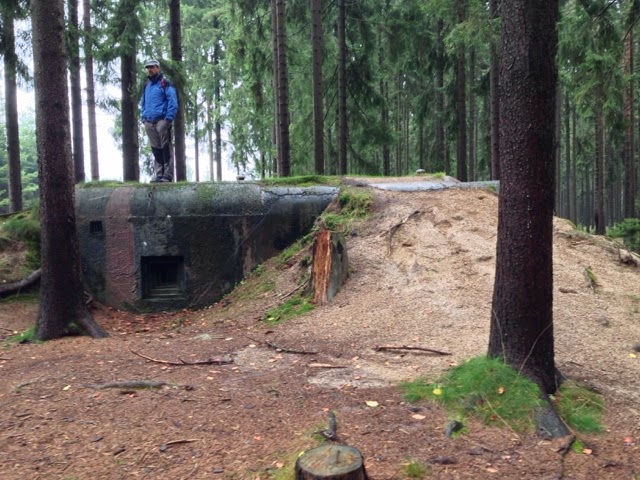Walking along the border between the Czech Republic and Austria, we are constantly reminded of the history of the area. Today was no different.
We left the Hotel Anton in Telc and traveled two hours to Stalkov Village where we began our hike.
Much of the trail was in a pine/spruce forest which was planted years ago for industrial purposes.It wasn't long before we came upon a "pillbox," a small armadillo-like structure which resembled a tiny mobile home partially buried in the ground. Our guide Lada, related a very sad story about the genesis of these blockhouses.
Much of the trail was in a pine/spruce forest which was planted years ago for industrial purposes.It wasn't long before we came upon a "pillbox," a small armadillo-like structure which resembled a tiny mobile home partially buried in the ground. Our guide Lada, related a very sad story about the genesis of these blockhouses.
When Hitler came to power in 1933, Czechoslovakia, which was only 15 years old, became very nervous about invasion. The area around Slavonice was part of the so-called Sudentenland and was inhabited predominantly by Germans. Likewise, many Austrians along the border were sympathetic to the Germans (Hitler was born in Austria, not Germany.)
Consequently, Czechoslovakia began constructing a line of fortifications along its borders -- a series of iron-enforced concrete bunkers connected by underground tunnels. Over 10,000 were built and were filled with 1.5 million mobilized Czechs and Slovaks. They were convinced that if they could hold the Germans at bay, the French and British would come to their aid, as agreed upon in the treaty after WW I. But instead, when Hitler met with the French and British in Munich in 1938, they gave into the dictator, thinking that allowing him to take the Sudentenland would appease him. The Czechoslovakian army, outnumbered 3 to 1, stood no chance, and were ordered home without firing a shot. Within 6 months, Hitler occupied the whole country.
Today there are about 100 of these still remaining, and they are not easy to find. Nature has taken over. Lada pointed out the small window, the hole for the gun, (see photo above) and, on the other side, the doorway (below). Here we could see how thick the walls are. It is hard to imagine that 3 to 4 men lived here in 24-48 hour shifts in such small quarters.
We continued on the trail for another couple of miles until we came to the ruins of Landstejn Castle. Our first impression of the barren castle is that it was made of poured concrete. Actually, it was built in the 13th century and was the biggest Romanesque castle in the Czech lands for many years. The second owners had ties to Charles IV, the famous ruler of the Czech lands, and held the property for 200 years. Then it had a series of owners. In 1771 lightning struck and it burned. The owner had no money to reconstruct, and it became a quarry to build other homes in the area. The real treat for this visit is the climb to the top to see the views of the surrounding countryside.
After a brief walk, we were picked up by our bus and taken to the ecofarm of Mrs. Langova for lunch and a tour. She impressed us as a very take charge woman and related her story. Her family had had a farm in a nearby village which was taken over by the state in 1948. After 1990, she petitioned for restitution, but the farm had been ruined by the communists. So she was given this farm "which was only partially ruined" along with her previous farm. Her sister now owns the other farm. Mrs. Langova and her family have worked very hard to restore these lands. She currently has "70 acres, 2 fish ponds, 60 goats, 2 children and 1 husband, who works as an electrician." Her children both have degrees in agriculture, and they plan to expand to 220 milking goats in the future. Her main business is making goat cheese and selling the young males for meat, especially around Easter.
Then we took a tour of the farm, including the goat barn. Ms. Langova is also the local guide for a water-powered sawmill that was still in use until the 1960s. She even demonstrated it for us.
Afterwards, our coach took us to the town of Slovenice, a charming enclave of 2,700 less than 3 miles from the Austrian border. Founded in the 1200s, it was settled by Germans and named Zlablings. During the 14th-16th centuries, the main trading route between Prague and Vienna passed through here and the economy flourished. As a result, beautiful 16th century renaissance houses were built with figural "sgraffitties," many of which have survived - the oldest dating to 1545. These are designs that are carved into the surface plaster of the buildings, exposing a different colored layer. It was a very popular architectural treatment during the renaissance and can be seen throughout the country.
After WW II, the vengeful Czechs forced out the German residents - 90% of the population - and took over their residences. However, when the communists took over, the city was fenced in on three sides because of its proximity to the Austrian border, and no one could move or sell their houses. After 1989 when the woods of the military zones were opened, it became a mecca for hikers and bikers and has been dubbed "Czech Canada."
Then back to our hotel in Telc and to dinner at a restaurant across the street, also owned by the hotel, where we were treated to a whole fish - eyeball and all. It was bony, but quite delicious.
















No comments:
Post a Comment